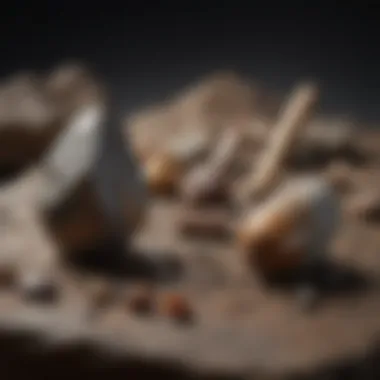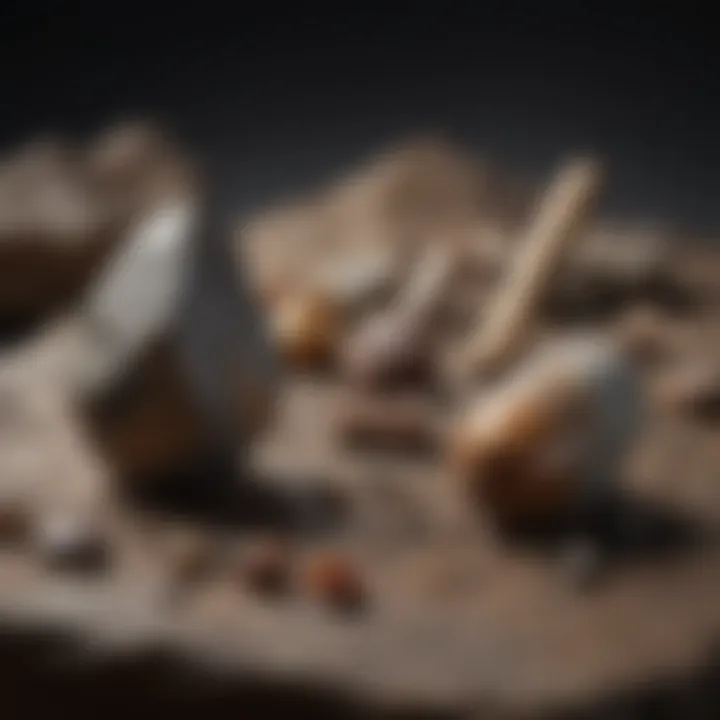The Role of Rocks and Crystals in the Stone Age


Intro
The Stone Age, a fascinating epoch in human history, spans a period where early humans relied heavily on their natural environment. Among the most significant elements of this era are the natural rocks and crystals that played a pivotal role in the development of tools, spiritual practices, and daily life. From the sharp edges of flint to the mesmerizing colors of agate, these materials shaped not only the way our ancestors crafted their possessions but also influenced their cultural expressions and beliefs.
As we step back in time, we gain insights into how these minerals were formed and utilized. Not merely functional objects, rocks and crystals carry stories from our ancestors, revealing their connection with nature and the world around them. Understanding these substances offers a window into the past – a glimpse of how humanity started to harness nature’s bounty for survival and creativity.
In this article, we will explore the significance of natural rocks and crystals during the Stone Age, detailing their geological origins, applications in various aspects of life, and the lasting impact they have on contemporary society. Let’s embark on this journey to unearth the hidden treasures of our planet that define an era of human ingenuity.
Featured Collectible of the Month
Overview
Each month, we highlight a unique collectible that exemplifies the beauty and significance of natural rocks and crystals. For this month, we present the stunning Carnelian. This vivid, red-orange stone has been cherished by civilizations for centuries. Its striking hue makes it a favorite among collectors and enthusiasts alike.
Historical Significance
During the Stone Age, carnelian was often shaped into beads and tools. It held both practical and symbolic value. Used in various types of jewelry, it was regarded as a protective stone. Early humans believed that carrying or wearing carnelian could ward off negativity and bring good fortune.
"Carnelian was more than just an ornamental stone; it was a medium for expression reflecting the beliefs and values of the time."
Identification Techniques
To truly appreciate the variety of natural rocks and crystals, knowing how to identify them is essential.
Visual Characteristics
When identifying stones, pay attention to their:
- Color: Look for vibrant shades and distinct patterns.
- Texture: Examine how smooth or rough the surface feels.
- Luster: Observe if it has a shiny, dull, or glassy finish.
- Shape: Notice how naturally it forms—sharp edges or rounded corners can hint at its type.
Resources for Identification
Several tools and resources can help with identification:
- Guidebooks: Books focused on rock and crystal identification can provide detailed descriptions.
- Online Platforms: Websites like Britannica and Reddit have communities dedicated to rock and crystal enthusiasts.
- Social Media Groups: Join discussions on platforms like Facebook where collectors share insights and discoveries.
In this article, we not only dig into the biological and historical narrative of stones and crystals but also engage the reader by providing practical ways to connect with these ancient resources. Through understanding, we cultivate respect for how these materials shaped our ancestors and continue to influence us today.
Foreword to the Stone Age
The Stone Age stands as a pivotal period in the timeline of human evolution, marking a time when early humans began to craft tools and manipulate their environment. This era also represents a deep connection between humanity and the natural world, particularly in the understanding and use of natural rocks and crystals. By exploring the complexities of this stone-centric epoch, we can begin to grasp not only the practical implications for survival but also the cultural and spiritual significance embedded in these materials.
Definition and Timeline
To grasp the enormity of the Stone Age, it is essential to define what entailed this period. Spanning roughly from 2.6 million years ago to about 3,300 BCE, the Stone Age is generally categorized into three phases: the Paleolithic, Mesolithic, and Neolithic.
- Paleolithic (Old Stone Age): This is the longest phase, characterized by the first crude tools and an entirely nomadic lifestyle.
- Mesolithic (Middle Stone Age): Marked by a climatic transition, people began to settle in semi-permanent sites, influencing tool technology significantly.
- Neolithic (New Stone Age): This era introduced agriculture and the domestication of animals, leading to more advanced tool construction and the establishment of permanent settlements.
Each phase not only informed the technologies of the time, but also the access to and understanding of natural resources, particularly rocks and minerals used as tools. The great variety of earth materials available, shaped by natural processes, played defining roles in these developments.
Significance in Prehistoric Development
The Stone Age represents a formative phase when human beings began to influence their environment using the raw materials found around them. The tools fashioned from stone and other materials were not simply for survival; they were symbols of ingenuity and adaptation.
The significance of rocks during this age manifests in diverse ways:


- Tool-making Innovation: The techniques for shaping stone laid the groundwork for advancements in technology that would define human progress.
- Cultural and Social Structures: The use of various types of stone determined settlement patterns and social organization, influencing how groups of humans interacted with one another and the earth.
- Spiritual Connections: Many communities developed complex relationships with the natural world, attributing spiritual significance to certain rocks and crystals, which can still echo today in various cultures.
This exploration taps into how ancient humans not only survived but thrived using their understanding of geological resources. Today, we look back at this era with curiosity, noting how our ancestors tapped into nature's bounty to carve out their existence.
Geological Foundations
Understanding the geological foundations is essential in grasping how natural rocks and crystals influenced Stone Age societies. The Earth itself is a treasure trove of materials that early humans utilized, both for practical and spiritual purposes. The rocks and crystals not only provided raw materials for tools and shelter but also formed a vital part of the cultural narratives of ancient peoples. Studying these elements gives us insights into the behaviors and technologies of our prehistoric ancestors.
Formation of Rocks and Minerals
Rocks and minerals are born from various geological processes. Depending on how they form, these natural materials fall into categories: igneous, sedimentary, and metamorphic. Each type reveals a piece of the Earth’s history and the environments where human ancestors lived.
- Igneous rocks originate from cooled magma or lava, showcasing a dramatic creation narrative written in the particles of the Earth itself. They are durable and often sharp, making them prime candidates for tool-making.
- Sedimentary rocks tell a different story. They form from layers of sediment compressed over time, often containing fossils and other remnants of past life. This variety reflects the Earth's changing landscape, which in turn mirrors the adaptation of early human societies seeking resources.
- Metamorphic rocks emerge from the transformation of existing rocks subjected to heat and pressure. This category illustrates the dynamic nature of geology and how it shapes materials crucial for survival and cultural practices.
Types of Rocks in the Stone Age
Igneous Rocks
Igneous rocks are prized for their hardness and sharp edges. Popular forms include granite and basalt. Their strength made them an essential choice for tools. These rocks are versatile; for example, flint, a type of chert, could be knapped to create sharp implements. This process is crucial as it reflects the greatest innovation during the Stone Age, propelling early humans into new realms of efficiency in hunting and crafting.
- Unique Feature: The ability to create various shapes and edges perfect for different tasks is a key advantage. However, the sheer weight of igneous rocks often made transport cumbersome, limiting certain uses in remote regions.
Sedimentary Rocks
Sedimentary rocks like sandstone and limestone are characterized by their layered appearance. They provide insight into the environmental conditions of their formation. Early humans utilized these rocks for construction and as pigment sources for art and ceremonies. These materials contributed significantly to shelters and communal areas, supporting social gatherings and cultural practices.
- Unique Feature: The presence of fossils within sedimentary layers provides a rich narrative of past life. However, their softer nature also means they are less durable than igneous rocks, sometimes crumbling under pressure or erosion.
Metamorphic Rocks
Metamorphic rocks, such as marble and schist, offer a unique blend of attributes derived from their parent materials. The transformation process can enhance their visual appeal, leading to an appreciation in art and spiritual contexts. Their beauty often drew early humans to craft decorative items and ceremonial tools.
- Unique Feature: Shiny surfaces, particularly in the case of schist, made them visually striking and ideal for display but also indicated a susceptibility to weathering.
The Role of Crystals
Crystals played multifaceted roles in the Stone Age—both as tools and as objects of reverence. The formation processes of crystals include cooling of magma, evaporation, and the processes of filtration through water. The aesthetics of crystals fascinated early humans, who believed them to possess protective and healing properties.
Formation Processes
The crystals form within different geological environments, like volcanic eruptions or in sedimentary basins. The chemical composition and the cooling rate determine the type of crystal formed, creating a stunning array of colors and structures. This diversity is crucial as it allowed early societies to use crystals not just functionally but also decoratively.
- Unique Feature: The sheer variety of crystal types provided various possibilities for use in both daily life and ritualistic practices. However, their brittleness posed challenges in survival situations—misusing them could mean losing an important tool or resource.
Common Crystals Found
Finding common crystals such as quartz, agate, and calcite was significant during the Stone Age. Each of these crystals had distinct applications: quartz for tool making due to its sharpness, while agates were often strung together for decorative purposes. These natural gems added depth to tools and ornaments, representing a blend of functionality and aesthetic value.
- Unique Feature: The clarity and distinct patterns within these common crystals enchanted many. However, their enchanting beauty could sometimes overshadow their practicalities in tool-making, leading to an underutilization of perhaps more effective materials.
Practical Applications of Rocks in the Stone Age
The Stone Age marked a significant evolution in the way early humans interacted with their environment, and rocks played a vital role in various practical applications. These natural materials were far more than mere components of the landscape; they were essential in shaping tools, constructing shelters, and forming the very core of daily life. A deeper understanding of these applications sheds light on the ingenuity of our ancestors.
Tool-Making Techniques


Knapping and Chipping Techniques
Knapping is an ancient art, refined through centuries of practice. Using harder stones as tools, early humans shaped flint or obsidian into sharp edges by strategically striking them. The brilliance of knapping lies in its efficiency. It allows for the creation of blades and points that are not only sharp but also durable. The key characteristic of this method is precision; a well-timed hit can produce a flake with a remarkably sharp edge essential for cutting and butchering.
One unique feature of knapping is the concept of flintknapping. This technique involves understanding the fracturing of stone at a molecular level, leading to the management of shapes and sizes for specific tools. The advantage here is the versatility of the resulting tools—they could be adapted for various tasks, like hunting or gathering.
However, knapping requires considerable skill and time, which could be a downside—especially for nomadic groups on the go. Despite this, the benefit of having finely crafted tools outweighed the costs, making this technique a staple.
Types of Stone Tools
Stone tools are not merely practical; they are a testament to human creativity and adaptation. The most prominent types include hand axes, scrapers, and projectile points. Each of these tools served a distinct purpose, showcasing innovation in design and functionality. The key characteristic that stands out is their multipurpose nature.
For instance, hand axes were designed for chopping, while scrapers were used to clean animal hides. What makes these tools remarkable is their longevity; stone tools rarely degrade, allowing archaeologists to study them thousands of years later. The advantage of stone tools lies in their availability; rocks are abundant in most environments.
However, their limitations are also noteworthy—for example, heavy stone tools could be cumbersome during hunting excursions, potentially causing fatigue. Yet their unique durability and effectiveness in various contexts made them indispensable to early human survival.
Construction and Shelter Materials
Use of Boulder and Aggregate
In the context of construction, boulders and aggregate served as foundational materials for some of the earliest shelters. These large rocks offered natural protection against elements and predators. The most significant characteristic of this approach is the inherent strength of boulders; their massive weight can withstand various weather conditions.
One key advantage of using natural materials like boulders is sustainability. These materials were readily available in the environment, minimizing the need for extensive resources. However, transporting and positioning large rocks could be a logistical nightmare, often limiting construction sites to those already rich in suitable materials.
Building Strategies
The strategy behind early shelters was both practical and communal. Early humans often constructed dwellings using available materials from their surroundings; this included not only boulders but also wood, skins, and grasses. One notable strategy was the circular layout, which helped maximize livable space while maintaining structural integrity.
The unique feature of these strategies is their adaptability; early humans adjusted their methods based on climate and available resources. The benefits are clear—such strategies provided not just protection, but also social cohesion, as groups gathered in shared spaces. Nevertheless, there were challenges; certain materials were less durable than stone, leading to continual repairs and maintenance. Ultimately, the effectiveness of these construction methods laid the groundwork for future architectural endeavors, demonstrating human innovation in shelter-building.
Cultural Significance of Rocks and Crystals
The role of natural rocks and crystals extends beyond mere physical attributes; they encapsulate the essence of human experience and understanding throughout the Stone Age. During this period, these materials were not just tools or raw resources, but also integral to the belief systems, artistic expressions, and rituals of early societies. The symbolic weight and the tangible qualities of rocks and crystals fostered a deep connection between humans and their environment, manifesting in various cultural practices that served both practical and spiritual purposes.
Spiritual and Ritualistic Uses
Rocks in Early Burial Practices
Rocks had significant importance in burial practices during the Stone Age. They were often used to create burial mounds or as markers for graves, serving both as a means to honor the dead and a way to define sacred spaces. The dense and durable nature of certain stones made them ideal for standing the test of time, ensuring that the memorials would persist long after the individuals were laid to rest.
These burial rocks often held specific spiritual significance, with many cultures believing they acted as guardians for the deceased, offering protection in the afterlife. This practice was not merely functional but deeply symbolic, reflecting a cultural reverence for the connection between life, death, and the materials of the earth.
Such practices also pointed to an early understanding of geology and the natural world. Choosing certain types of stone—like granite for its hardness or limestone for its prominence—showed a careful consideration of properties that were believed to possess otherworldly qualities.
"The stones that mark the resting places of our ancestors remind us of their enduring spirit and connection to our world."
Crystals and Healing Beliefs
Alongside rocks, crystals held deep meaning in the realm of healing beliefs. Early societies placed a high premium on the properties attributed to different minerals, believing that crystals could channel energy or promote wellness. Various forms of quartz, for example, were thought to have purifying qualities and were often embedded in ceremonial regalia or carried by shamans during rituals.
The allure of crystals lay in their beauty and perceived powers; people often shared stories of miraculous recoveries linked to the presence of specific stones. Throughout history, these beliefs have had a lasting impact, as various cultures insisted on the healing properties of crystals, such as amethyst for calming or obsidian for protection.
Yet, while the allure of crystals persists, it is crucial to recognize the potential downsides; the misunderstanding of their capabilities could lead to misplaced faith in their abilities, diverting attention from medical advancements.
Symbolism and Art
Petroglyphs and Carvings
Petroglyphs and carvings hold a prominent place in the artistic legacy of the Stone Age. These ancient forms of expression are not only an artistic endeavor but also carry significant cultural and spiritual meaning. Stories of hunting, rituals, and deities were etched into rock faces, enduring the ages as a window into the beliefs and lives of those early peoples.
The choice of rocks for these carvings varied, often depending on local availability and the desired effect. Softer forms of stone were typically used for more intricate designs, while harder stones served for great narratives depicted on cliffs or large boulders. The permanence of these symbols offered a sense of security and stability, a lasting testament to their creators’ experiences and teachings.
"Every petroglyph scratches the surface of history, whispering to us about lives once lived and beliefs firmly held."
The Use of Natural Pigments


In conjunction with stone tools, natural pigments derived from rocks also became a significant element of artistic expression during the Stone Age. These pigments, ground from minerals and mixed with binders, allowed early humans to create vivid murals, body paints, and ceremonial decorations. The colors strongly influenced the aesthetic landscape of their societies and captured the essence of their experiences.
The uniqueness of these pigments derived from their diverse availability and the wide array of colors they could produce—from deep reds to vibrant yellows and deep blacks. While the creativity fostered by natural pigments added depth to expressions, sourcing them did involve challenges that could result in variability in quality. Additionally, benefiting from these natural colors required a certain expertise, which varies in accessibility across different groups.
Continuing Legacy of Stone Age Materials
The legacy of the Stone Age is deeply embedded in our present-day understanding of human civilization. It’s not merely about the rocks and crystals themselves, but how they shaped the very foundation of human life and society. Rocks and crystals aren’t just artifacts to be collected; they are remnants of an age that molded our ancestors’ relationships with the environment. This continuity holds great significance as it not only reflects our past but also informs our contemporary interactions with these natural materials.
Historical Discoveries
Archaeological Sites
The excavation of historical sites is like unearthing a treasure chest of knowledge about our ancestors. Sites like Lascaux in France and Stonehenge in England provide a window into the lives of humans who lived thousands of years ago. These locations reveal how early humans utilized local rocks and minerals for tools and construction, anchoring their place in history. The significance of such sites rests in their ability to tell a story: how communities thrived, adapted, and engaged with their surroundings.
The key characteristic of archaeological sites is their ability to yield artifacts that tell us about the socioeconomic conditions of the time. Each shard of stone or fossilized remnant contributes to a picture of how early humans made decisions based on the materials available to them. For this article, discussing archaeological sites is vital because they are the focal points from which we can derive insights about the utility and symbolism of natural stones. Moreover, these sites often hold unique features, such as ancient graffiti or burial grounds, which give researchers clues about spiritual beliefs and communal activities.
Yet, there's a downside. Preservation issues and modern developments can endanger these sites. This means a constant battle between excavation and conservation, reminding us that while we dig into our past, we need to protect its physical manifestations.
Famous Findings
Famous findings, like the neolithic stone tools discovered in the Olduvai Gorge, serve as a tangible link to our evolutionary progress. Such discoveries highlight the evolutionary steps humans took towards sophistication in tool-making, pointing to a rich history intertwined with the geology of the region. These findings are celebrated for their clarity in showcasing the technological advancements that our ancestors achieved.
Key characteristics of these famous findings include their ability to exemplify specific milestones in human history. These artifacts are not just relics; they serve as educational tools that enable scholars and enthusiasts alike to grasp how the Stone Age material culture developed through innovation and adaptation. The remarkable age and craftsmanship of items like the hand axe indicate a level of proficiency that many modern contexts can still learn from.
However, the allure of famous findings also presents challenges. The excitement often leads to plundering, where valuable pieces end up in private collections rather than museums. Thus, while such findings spark interest, we must tread carefully to respect the importance of heritage and ensure that these remarkable artifacts are preserved for future generations.
Modern Interest in Rocks and Crystals
Collecting and Hobbyist Culture
In today's world, a strong interest in collecting rocks and crystals has blossomed into a thriving hobbyist culture. Many individuals find solace and satisfaction in gathering everything from common quartz to rare gemstones. This not only honors the legacy of the Stone Age but also cultivates an appreciation for the earth's geological wonders. Collectors often form clubs or online communities, exchanging information and sharing their passion with others who have a similar appreciation.
The characteristic that stands out here is the sense of community found among collectors. This shared enthusiasm often leads to organized outings and events where individuals can hunt for their treasures together. Such gatherings not only enhance knowledge but also build lasting friendships grounded in a common interest.
However, this culture can have its drawbacks. Those new to collecting sometimes exploit natural resources irresponsibly, leading to environmental degradation. Therefore, while enthusiasm for collecting is commendable, it’s crucial to balance passion with responsibility, keeping in mind the importance of conservation.
Contemporary Uses and Innovations
Contrasting with ancient practices, today's applications of rocks and crystals have expanded far beyond tool-making to various fields including art, technology, and healing. The rise of trends like crystal healing and geological art demonstrates how ancient practices have evolved to fit modern sensibilities. Artists now employ stones to enhance their work, while wellness enthusiasts turn to crystals for their purported healing properties. These modern interpretations keep the spirit of the Stone Age alive while adapting it for contemporary use.
The primary feature that characterizes contemporary uses is their interdisciplinary nature, blending aesthetics, science, and spirituality. This has led to innovations in various sectors, such as architecture using naturally sourced materials for sustainable building practices or integrating minerals into wellness therapies. Each new use reflects an ongoing dialogue between humans and the earth’s resources, fostering a relationship that honors both history and the future.
Yet, challenges arise. The commercialization of crystals can lead to misinformation about their properties and uses, leaving consumers confused. Additionally, overharvesting poses a risk to the natural formations many seek to admire. Thus, as we embrace these innovations, we must also ensure we remain informed and responsible consumers, taking care to protect the integrity of the resources we cherish.
The End
The exploration of natural rocks and crystals within the Stone Age carries profound significance, revealing not just the practical aspects of their use, but also their far-reaching implications in shaping early human societies. Recognizing how these materials influenced daily practices, tool-making, and spiritual beliefs allows us to appreciate their role in the evolution of human culture.
Reflection on Natural Materials
Natural materials, such as rocks and crystals, represent a bridge between humanity and the Earth’s geological history. The environment in which early humans lived was filled with diverse materials that informed not just survival, but also creativity and expression. For instance, quartz crystals were utilized for their clarity and sharp edges, making them not only functional tools but also items of beauty. Additionally, sedimentary rocks gifted hominids the means to channel their artistic instincts—petroglyphs etched into stone are a testament to their innovative spirit.
Moreover, collecting and utilizing such natural materials aided in the establishment of trade networks long before written language emerged. Interfaces between groups were often built on the exchange of favored stones—a fascinating glimpse into early economic systems.
"Materials are not passive tools; they shape our perceptions and our identities."
Future Exploration and Research Opportunities
The study of rocks and crystals from ancient times holds a treasure trove of insights into our past and can guide future explorations. One area ripe for research is the socio-cultural significance of specific materials in different regions. Understanding local geologies can shed light on why certain stones were favored over others in various communities.
Additionally, advancements in technology, such as ground-penetrating radar and 3D modeling, provide new avenues for archaeological digs. These innovations can expose layers and artifacts that would have been unfeasible to reveal through traditional methods. Moreover, the integration of geological and anthropological studies may catalyze a more holistic understanding of how humans and their environments influence each other.
As we move forward, the appreciation for these ancient materials not only enriches our knowledge but also emphasizes the need to preserve geological sites. They are remnants of our shared heritage, serving as a reminder of the intricate dance between nature and humanity throughout history. Understanding and exploring these connections will foster greater respect for the natural world, ensuring that future generations can uncover the stories that lie within the stones.



